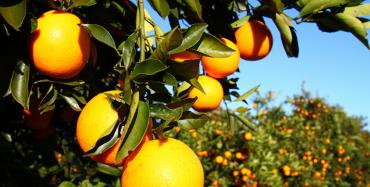
The U.S. Department of Agriculture (USDA) released its latest crop projections with grim news for the Sunshine State. 
On Tuesday, the USDA’s National Agricultural Statistics Service (NASS) released it latest projections for the 2017-2018 orange crop and downgraded Florida's orange projections for the month of December.
The latest projections show 46 million boxes of Florida oranges will be produced this season, down 8 percent from November’s projections and 33 percent lower than last year.
The December forecast numbers are the lowest since the 1944-1945 citrus production season of 42.2 million boxes.
That isn't the only area faring poorly in the state's citrus industry, though.
Early, midseason and Navel varieties in Florida are also in bad shape, as NASS projects 19 million boxes of those oranges this season -- a drop of 10 percent from what was projected last month and a decrease of 42 percent from last year.
Florida Valencia oranges are also down with the latest projections forecasting 27 million boxes, down 7 percent from what was projected last month and a decrease of 24 percent from last year.
Florida suffered over $2.5 billion in agriculture losses following Hurricane Irma, a Category 4 monster storm which engulfed most of the state in heavy rains and high-speed winds back in September.
Florida’s citrus industry took the biggest hit from Hurricane Irma, with preliminary estimates finding the storm devastated the state’s largest agricultural industry with nearly $761 million worth of damage.
Florida has long been one of the country’s top citrus growers and was responsible for almost three-fourths of all U.S. orange production 10 years ago. That number has decreased over the years, with Florida now accounting for 58 percent of all U.S. orange production.
California comes in second in orange production, accounting for about 41 percent of the federal total.
Florida Agriculture Commissioner Adam Putnam weighed in on the news on Tuesday.
“While much of the state has recovered and moved on from Hurricane Irma, Florida’s citrus growers continue to grapple with the unprecedented damage, which is still unfolding in many groves," Putnam said.
Putnam has been particularly vocal about the need for federal assistance to help Florida agriculture on the road to recovery. Putnam himself has a personal connection to the citrus industry, coming from a family of growers.
“While much of the state has recovered and moved on from Hurricane Irma, Florida’s citrus growers continue to grapple with the unprecedented damage, which is still unfolding in many groves,” Putnam explained. “Florida’s growers need support and they need it as quickly as possible.”
Both Putnam and the Florida congressional delegation have been pushing the Trump administration for federal relief for the state’s citrus industry. Last month, the White House sent its its latest relief proposal but Florida agriculture was left off the list of priorities, prompting Putnam and Florida congressmen to criticize the Trump administration.
“Hurricane Irma hit Florida over two months ago, the losses this storm caused to Florida’s agriculture industry across the entire state are staggering,” said U.S. Rep. Tom Rooney, who crafted language that would enable the USDA to provide $1.5 billion in emergency disaster assistance to address the catastrophic crop losses. “For the citrus growers, fruit is still dropping off the trees. The trees’ root systems are rotting; there is no telling how badly this will affect the industry’s future and so far Washington has done nothing.”
The decimating effects of Hurricane Irma still haven’t been totally determined, but it’s possible the numbers could be as low as 40 percent or as high as 100 percent for some growers in Florida.
Even before Hurricane Irma impacted around 70 percent of citrus trees in the Sunshine State, Florida’s orange production has been declining in recent years, though, with the latest numbers a fraction of the record-high 244 million boxes of oranges in the 1997-1998 season.
For now, it appears Florida still has a long road ahead to recovery and the citrus industry continues to struggle as state lawmakers wait for a national solution to the problem.
Reach reporter Allison Nielsen by email at allison@sunshinestatenews.com or follow her on Twitter: @AllisonNielsen.


